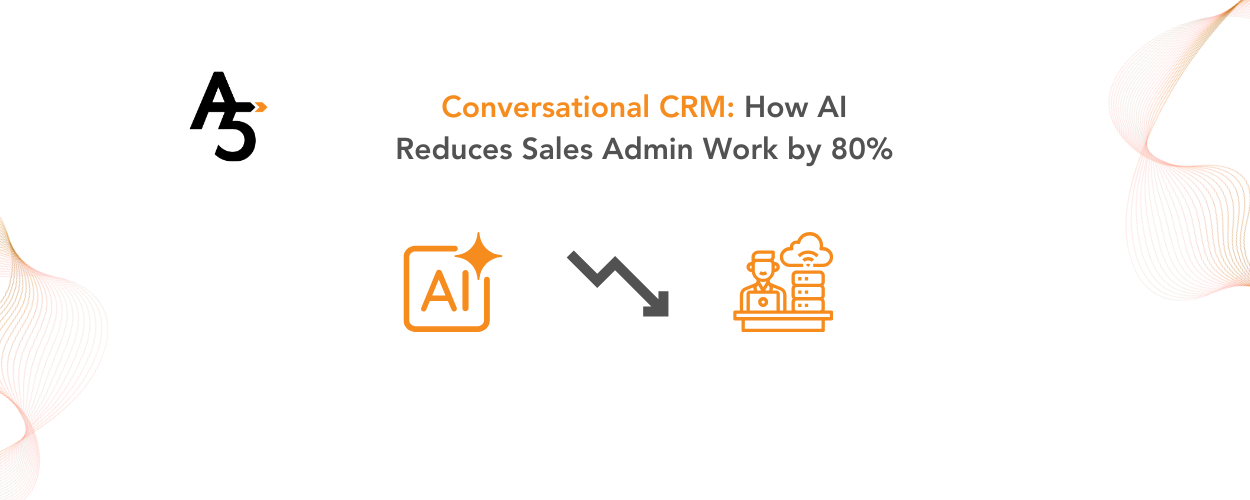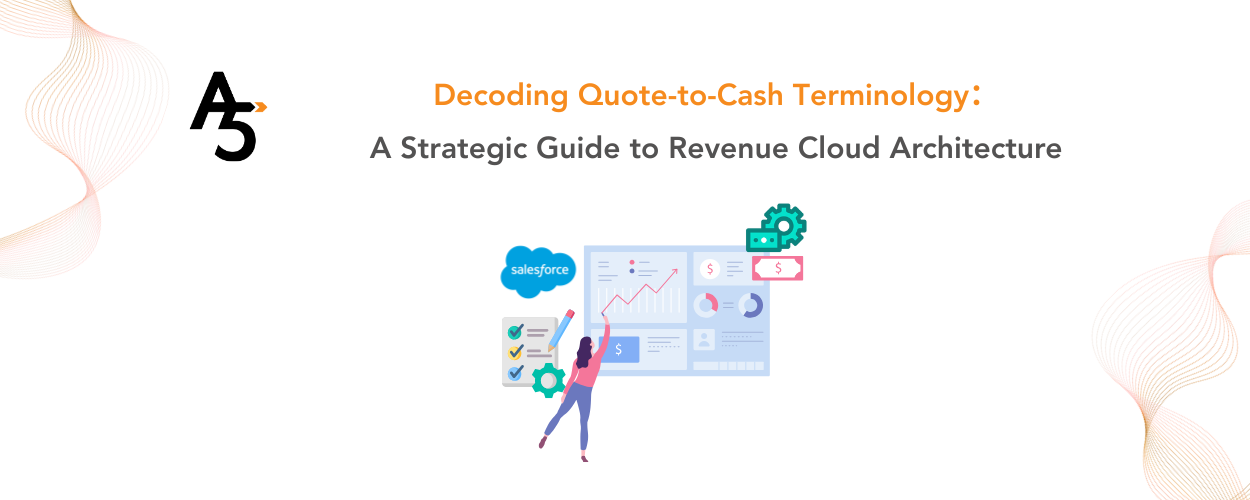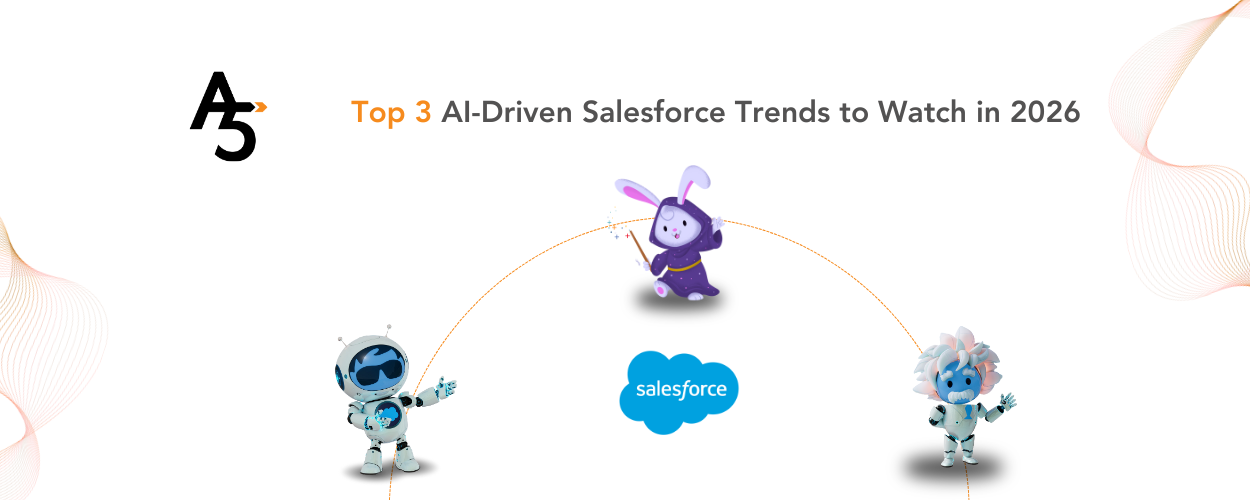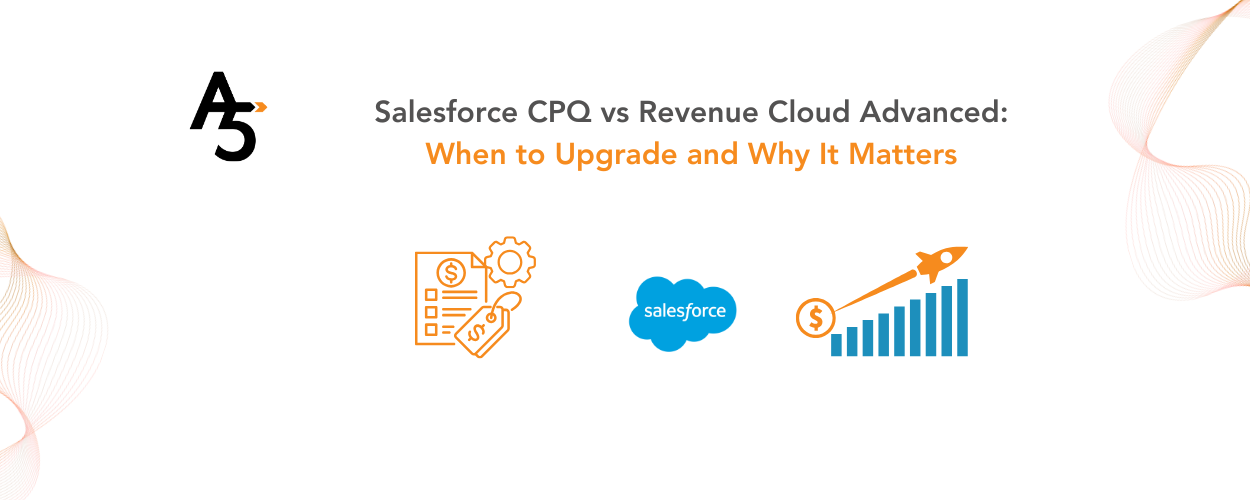Your sales reps are drowning in admin work. They spend less than 30% of their time actually selling. The rest disappears into data entry, app switching, and manual processes that kill productivity and lose deals. This isn’t a training problem. It’s a fundamental flaw in how traditional CRM was designed. Conversational CRM offers a radically different approach: it eliminates up to 80% of sales admin work by replacing form-filling with natural conversations. Instead of logging into five systems to generate a quote, your rep asks an AI agent in Slack. The agent does the work in seconds.
This shift from traditional CRM to conversational CRM isn’t coming—it’s already here. And the companies adopting it first are seeing dramatic results. Let us show you exactly how conversational AI reduces sales admin work, with real numbers from enterprise implementations.
The Real Cost of Sales Admin Work (And Why CRM Isn't Helping)
Let’s start with the problem. Research shows that 70% of sales reps feel overwhelmed by the number of tools they use daily. The average rep toggles between 10-plus applications every single day. Email. Calendar. Salesforce. Slack. Video calls. Contract management. CPQ systems. Document storage. Each switch costs time. Each login creates friction. Each manual data entry is a chance for errors.
A Fortune 500 financial services company we worked with tracked this precisely. Their account executives lost 2.3 hours daily to context switching and admin tasks. That’s 28% of their workday spent on work that doesn’t close deals. When we implemented conversational CRM using AI agents in Slack, their deal velocity increased by 41% in the first quarter. Same team. Same territory. Just less admin work.
What Is Conversational CRM?
Conversational CRM replaces traditional software interfaces with natural language conversations. Instead of clicking through forms and menus in Salesforce, your sales team talks to AI agents in the tools they already use — like Slack or Microsoft Teams.
Think of it this way: traditional CRM makes your team serve the database. Conversational CRM makes AI agents serve your team. Here’s a simple example:
Traditional CRM Process (Even with Sales Cloud + Revenue Cloud):
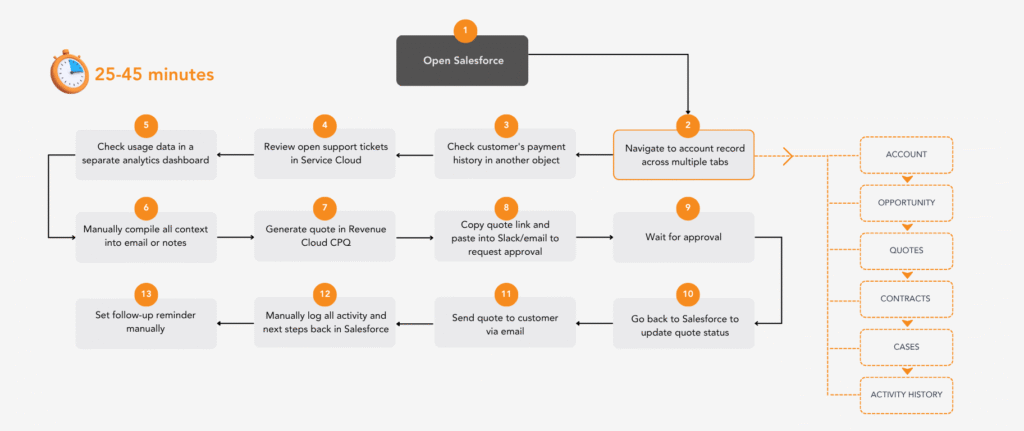
Conversational CRM Process (with AgentIQ):
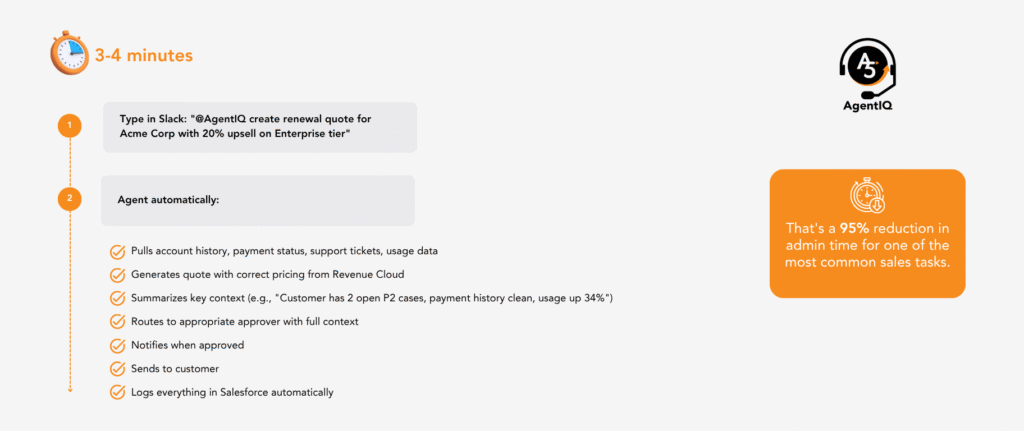
5 Ways Conversational CRM Eliminates Sales Admin Tasks
Let us break down exactly how conversational AI reduces sales admin work across the most time-consuming activities:
1. Data Entry and CRM Updates
The Old Way
Sales reps spend 17% of their time on data entry. After every call, they log into Salesforce and manually update fields. Opportunity stage. Next steps. Key discussion points.
Contact information. Follow-up tasks.
The Conversational AI Way
AI agents listen to your conversations (with permission) and update records automatically. After a customer call, the agent summarizes key points, updates the opportunity stage, creates follow-up tasks, and logs everything in Salesforce. No manual entry required.
Time Saved: 8-12 hours per rep per week
2. Quote and Proposal Generation
The Old Way
Creating a quote requires checking product catalogs, cross-referencing pricing tiers, building configurations in CPQ systems, getting approval through email chains, and manually sending to customers.
Average time: 3 days.
The Conversational AI Way
Sales rep asks the AI agent to generate a quote. The agent pulls account history, applies correct pricing rules, generates the document, routes through approval workflow automatically, and delivers to the customer.
Average time: 4 minutes.
A global technology company we worked with cut quote turnaround time by 94% using conversational CRM. Their sales cycle length dropped by 33% as a direct result.
Time Saved: 6-8 hours per rep per week
3. Information Gathering and Research
The Old Way
Before customer meetings, reps spend hours researching. They check Salesforce for account history. Search email for past conversations. Look up support tickets in another system. Review contract terms in the legal database. Pull usage data from analytics platforms.
The Conversational AI Way
Rep asks the AI agent: “Prepare me for the Acme Corp renewal call.” The agent pulls information from all systems, summarizes key points, flags risks, suggests talking points, and delivers a briefing document. All in 30 seconds.
Time Saved: 5-7 hours per rep per week
4.Forecasting and Reporting
The Old Way
Sales managers spend hours each week building forecast reports. They pull data from Salesforce, clean it in Excel, update probability scores manually, and compile everything into presentation slides.
The Conversational AI Way
Manager asks: “What’s our Q4 forecast looking like?” The AI agent analyzes pipeline in real-time, flags at-risk deals, surfaces trends, and generates a forecast summary. Updates happen automatically as deals progress.
Time Saved: 10-15 hours per manager per week
5.Internal Coordination and Approvals
The Old Way
Getting approvals means email chains, calendar invites, and waiting for responses. A custom pricing approval might take 3-5 days bouncing between sales ops, finance, and leadership.
The Conversational AI Way
AI agents route approvals automatically based on business rules. When a rep needs custom pricing, the agent identifies the right approvers, presents the context, and notifies the rep when approved. All within the same conversation thread.
Time Saved: 4-6 hours per rep per week
Quick Answer: How Conversational AI Reduces Sales Admin Work
Conversational AI reduces sales admin work by 60-80% through three mechanisms:
1. Automated Data Entry: AI agents listen to conversations and update CRM records automatically, eliminating 8-12 hours per rep weekly
2. Intelligent Workflow Orchestration: Agents handle quote generation, approvals, and coordination across systems in minutes instead of days
3. Contextual Information Gathering: AI compiles research from multiple systems in seconds, saving 5-7 hours per week
Implementation typically follows three phases over 12-18 months, with payback periods of 4-6 months.
The Technology Behind Conversational CRM
You might be wondering: how does this actually work? Let us explain the technology without getting too technical.
Conversational CRM combines three key technologies:
- Large Language Models (LLMs): These AI systems understand natural language. When your rep types “create a quote for Acme,” the LLM understands the intent and figures out what information is needed.
- Workflow Automation: Once the AI understands what you want, it triggers automated workflows. It pulls data from Salesforce, applies your business rules, routes through approval chains, and executes tasks across multiple systems.
- Platform Integration: The AI agent connects to all your revenue systems through APIs. Salesforce Sales cloud, Revenue Cloud, email, calendar, analytics — everything talks to the agent, and the agent orchestrates work across all of them.
The key innovation is the conversational interface. Instead of building complex integrations between systems, you build one AI layer that sits on top of everything. Your team talks to the AI. The AI talks to your systems.
The market momentum is undeniable. Gartner predicts that 40% of enterprise applications will integrate task-specific AI agents by 2026, up from less than 5% in 2025. B2B sales organizations using generative AI will see a 50% reduction in customer meeting preparation and prospecting time by 2026. By 2026, 45% of individuals will search for information and engage in dialogue with brands via GenAI, fundamentally changing how revenue teams interact with customers and data.
Conversational CRM Use Cases: 5 Industries Transformed
Let us walk you through concrete scenarios where conversational CRM delivers measurable impact:
Use Case 1: Manufacturing - Streamlining Complex Quote-to-Cash
☒The Challenge: A typical manufacturing company manages quotes across Salesforce, ERP systems like SAP, and custom pricing engines. A single quote requires coordinating between sales, operations, finance, and legal — often taking 8-15 days from request to customer delivery.
☑The Conversational CRM Solution: Sales reps request quotes directly in Slack: “Create quote for Acme renewal with custom volume pricing.” AI agents pull customer history from Salesforce, check inventory and production capacity in the ERP, apply pricing rules, generate the quote, route for approvals, and deliver to the customer — all automatically.
Expected Impact:
- Quote turnaround: 12 days → 2-4 hours (85-90% reduction)
- Admin time per deal: 6+ hours → under 1 hour
- Sales cycle compression: 30-40% faster close rates
- Annual time savings: 10,000+ hours for a 50-person sales team
Use Case 2: Financial Services - Eliminating Context Switching
☒The Challenge: Financial services account executives typically use 15+ systems daily: Salesforce for CRM, proprietary trading platforms, compliance databases, document management systems, client portfolio tools, and more. Reps spend 2-3 hours per day just gathering context and updating records across systems.
☑The Conversational CRM Solution: Using AgentIQ, all systems connect through Slack. When a rep types “Prepare me for Acme renewal call,” the AI agent automatically pulls account history, portfolio performance, compliance status, recent support tickets, and competitive intelligence — delivering a comprehensive briefing in seconds. After the call, the agent logs notes and next steps across all relevant systems automatically.
Expected Impact:
- Admin time reduction: 2+ hours/day → 30-45 minutes/day (70% reduction)
- Deal velocity increase: 35-45% faster progression through pipeline
- Quota attainment improvement: 15-25% more reps hitting targets
- Rep satisfaction: Significant improvement in employee engagement scores
Use Case 3: Technology/SaaS - Accelerating Quote and Approval Cycles
☒The Challenge: SaaS companies often have complex quoting processes requiring coordination between sales, sales ops, legal, finance, and customer success. Standard quotes may take 2-3 days, while custom deals can take weeks as documents and approvals move through email chains and manual reviews.
☑The Conversational CRM Solution: AI agents in Slack automate the entire workflow. When a rep needs a quote, they simply describe the deal. The agent generates the quote using Revenue Cloud, identifies the right approvers based on deal size and terms, routes with full context, tracks approval status, and notifies when complete — all without the rep leaving Slack.
Expected Impact:
- Quote generation: 2-3 days → 5-10 minutes (90-95% reduction)
- Sales cycle: 25-40% compression for standard deals
- Admin time per rep: 10-15 hours/week → 2-4 hours/week
- Revenue acceleration: Faster quote delivery enables faster booking
Use Case 4: Professional Services - Unifying Fragmented Tech Stacks
☒The Challenge: Consulting and professional services firms typically cobble together 20+ tools: Salesforce, project management systems, resource planning tools, time tracking, invoicing, document collaboration, and more. Reps lose hours daily switching contexts, and critical information falls through the cracks between systems.
☑The Conversational CRM Solution: AgentIQ creates a unified conversational interface across all systems. Sales teams access everything through Slack — checking resource availability, creating project plans, generating proposals, tracking delivery status, and updating forecasts. AI agents handle the orchestration, surfacing the right information at the right time with intelligent nudges.
Expected Impact:
- App switching: 40+ daily switches → under 10
- Context switching time: 1.5-2 hours/day → 20-30 minutes/day (70-80% reduction)
- Data accuracy: Significant reduction in manual entry errors
- Employee retention: Improved satisfaction reduces costly turnover
Use Case 5: Healthcare - Balancing Compliance with Productivity
☒The Challenge: Healthcare sales teams (medical devices, pharma, health tech) operate under strict compliance requirements. Every customer interaction must be documented, but reps spend enormous time manually logging activities while ensuring HIPAA compliance and regulatory adherence.
☑The Conversational CRM Solution: Conversational AI agents automatically capture meeting notes, log activities in Salesforce, apply appropriate data masking for PHI, route compliance approvals, and maintain complete audit trails — all while keeping reps focused on physician and healthcare system relationships.
Expected Impact:
- Compliance logging time: 45-60 minutes/day → 5-10 minutes/day (90% reduction)
- Audit readiness: Complete, automated documentation trails
- Sales capacity: 15-20% more time for customer-facing activities
- Risk reduction: Automated compliance checks reduce violations
Why These Use Cases Work Across Industries
What makes conversational CRM powerful isn’t industry-specific features — it’s the universal pattern of replacing fragmented tools with unified conversational workflows.
Every industry has too many systems. Every sales team loses time to context switching. Every organization struggles with data entry and compliance. Conversational CRM solves these universal problems through a common approach: bring work to where conversations happen, automate orchestration, and keep humans focused on judgment and relationships.
Why Conversational CRM Works Better Than Traditional Automation
You might be thinking: “We already have automation. How is this different?” Great question. Traditional automation connects systems with rigid workflows. If A happens, then do B. It’s powerful but inflexible.
Conversational CRM adds three critical capabilities:
1.Understanding Context
Traditional automation follows scripts. Conversational CRM understands intent. When a rep says “I need pricing for Acme’s renewal,” the AI knows to check their current contract, renewal date, usage patterns, payment history, and competitive context. It doesn’t just pull a price list — it provides intelligent recommendations.
2.Handling Exceptions
Traditional automation breaks when something unexpected happens. Conversational CRM adapts. If a customer needs custom terms that fall outside standard workflows, the AI can route to the right person, explain the situation with full context, and get a decision without derailing the entire process.
3.Natural Interface
Traditional automation requires training. You have to learn which buttons to click, which fields to fill, which order to do things. Conversational CRM just requires you to ask questions like a normal human. No training needed. Adoption happens naturally.
Conversational CRM Implementation: 3 Maturity Stages
Based on our implementations with several enterprise clients, here’s how conversational CRM reduces sales admin work over time:
Stage 1: Task Automation (Months 1-3)
You start with simple, high-frequency tasks. Quote generation. CRM updates. Meeting scheduling. The AI handles discrete activities that previously required manual work.
Admin Time Reduction: 20-30%
Stage 2: Workflow Orchestration (Months 4-9)
You connect multiple tasks into end-to-end workflows. When a deal closes, the AI automatically handles provisioning, invoicing, handoff to delivery, and forecast updates. Multiple systems work together seamlessly.
Admin Time Reduction: 40-60%
Stage 3: Intelligent Assistance (Months 10+)
The AI starts proactively suggesting actions. It flags at-risk deals before you ask. It prepares briefings for customer meetings automatically. It identifies cross-sell opportunities based on usage patterns. It becomes a true assistant, not just a task executor.
Admin Time Reduction: 60-80%
Most companies see the biggest impact in Stage 2 when workflows connect across systems. That’s where hours of coordination work disappear.
What It Takes to Implement Conversational CRM
Let us be direct: implementing conversational CRM isn’t simple. Here’s what’s actually required:
1. System Integration (2-4 months)
Your AI agents need access to every system in your revenue stack. That means APIs, authentication, data synchronization, and error handling. Most companies underestimate this work by 3-5x.
One retail client had 47 different systems. Integration took 11 months just to get read-access working reliably. Budget accordingly.
2. Agent Design (1-3 months)
Generic chatbots don’t cut it. You need agents designed around your specific workflows. How does your sales process work? What are your approval chains? Who needs notification when?
This requires detailed business process mapping. You can’t skip this step.
3. Security and Compliance (1-2 months)
When agents access everything, security becomes critical. You need granular permissions, audit trails, data masking for sensitive information, and compliance controls.
A healthcare client needed agents that could access patient data for service issues but automatically redacted PHI in logs. This level of control takes serious engineering.
4. Change Management (Ongoing)
Technology is 30% of the work. Getting your team to actually use conversational workflows is the other 70%. Training, documentation, champions programs, and executive sponsorship all matter tremendously.
We’ve seen implementations fail not because the agents didn’t work, but because nobody convinced the sales team to change their habits.
The Salesforce Agentforce Advantage
At Dreamforce 2025, Salesforce is making a major announcement about their conversational AI strategy. They’re positioning Slack as the conversational interface for their entire platform, powered by Agentforce — their new agentic AI system.
This matters because Salesforce is solving the integration challenge. If you’re already on Salesforce and Slack, the technical foundation is being built for you. You won’t need to spend months integrating systems. The hard infrastructure work is done.
Agentforce combines:
- Deep integration with Salesforce data
- Natural language understanding through Einstein AI
- Workflow automation across Sales Cloud, Service Cloud,Marketing Cloud, and beyond
- Security and compliance built into the platform
For companies already invested in the Salesforce ecosystem, Agentforce represents the fastest path to conversational CRM. You’re building on a foundation, not starting from scratch.
The Dreamforce keynote demonstrated:
- Employee agents that reduce admin work automatically
- Real-time workflow orchestration across enterprise apps
- Conversational interfaces that feel natural, not robotic
- Live demos of sales reps never logging into Salesforce
This is Salesforce’s vision: CRM that works through conversation, not clicks.
The Real Risks You Need to Consider
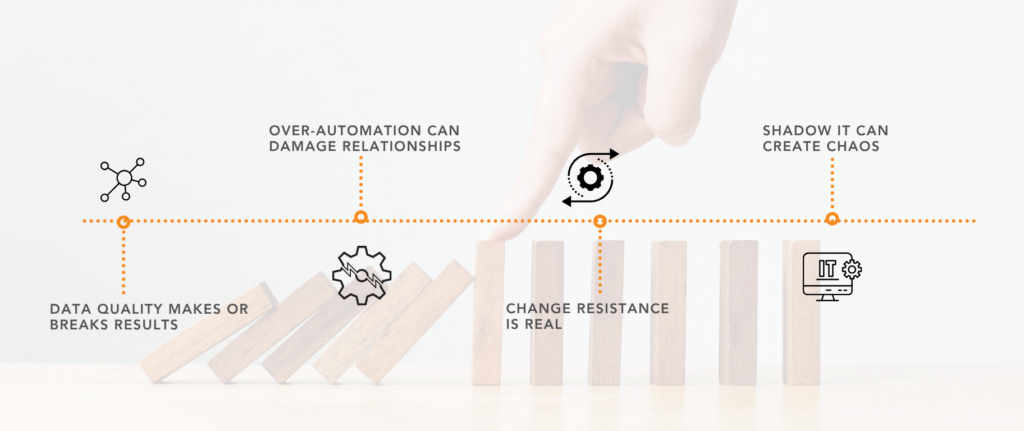
Let us address the legitimate concerns you should think about:
Data Quality Makes or Breaks Results
AI agents amplify whatever data quality you have. If your Salesforce instance is full of duplicates, stale contacts, and missing information, conversational AI will surface those problems immediately.
One client had to pause their implementation for two months to do a data cleanup project. It was painful but necessary. Budget for this.
Over-Automation Can Damage Relationships
Just because you can automate something doesn’t mean you should. A retail client automated all renewal conversations for efficiency. Customers felt like they were talking to robots. Renewal rates dropped.
The fix: Use AI for information gathering and preparation, but keep humans in the relationship moments. Automate the admin work, not the relationship.
Change Resistance Is Real
If your team has been through three CRM migrations in five years, they’re tired. They don’t want another new system, even if it’s conversational.
You have to earn adoption through demonstrated value. Start small. Show quick wins. Let early adopters become champions. Don’t mandate usage from day one.
Shadow IT Can Create Chaos
When conversational agents are easy to build, people will build them. Without governance, you’ll end up with 50 different agents doing similar things differently.
One enterprise client discovered their sales teams had built 23 unauthorized pricing bots, each with different discount logic. You need clear ownership, approval processes, and agent lifecycle management.
The ROI That Matters to Executives
Here are the metrics that get CFO approval:
Time Savings
- 8-12 hours per rep per week on admin work eliminated
- 12,400 hours per year for a 50-person sales team
- At $75/hour fully-loaded cost = $930,000 annual savings
Revenue Impact
- 25-40% reduction in sales cycle length
- 15-25% increase in deals closed (more time selling)
- For a team with $50M quota = $7.5M-12.5M incremental revenue
Efficiency Gains
- Quote turnaround: 3 days → 4 minutes (94% faster)
- Forecast accuracy: 78% → 95% (better planning)
- Rep quota attainment: 58% → 79% (more winners)
Cost Reductions
- $3,200 → $340 per deal in admin costs (one client example)
- 30% reduction in tech stack costs (consolidated tools)
- 27% → 16% sales turnover (better retention)
The payback period is typically 4-6 months for enterprise implementations.
How A5 Helps Companies Implement Conversational CRM
This is where we need to be transparent about A5’s role. You can build conversational CRM yourself. Some companies do. The ones with large development teams, deep Salesforce expertise, and patient executives who will tolerate a 2-3 year journey. Most companies don’t have that luxury. They need results in quarters, not years.
Here’s what A5 brings:
- Pattern Recognition: We’ve built conversational CRM for several industries- manufacturing, technology, retail, finance and payment services, professional services, healthcare and the like. We know what works because we’ve done it 30+ times. You don’t have to learn through expensive mistakes.
- Pre-Built Agent Frameworks with AgentIQ: We have production-ready templates for common workflows: quote generation, opportunity management, renewal forecasting, customer onboarding, support escalation. Our AgentIQ framework specifically connects Revenue Cloud, Sales Cloud, and Service Cloud directly into Slack, delivering AI-powered summaries and next-best actions in real time. These frameworks cut implementation time by 60-70% and eliminate the fragmented workflows that slow down revenue teams.
- Salesforce and Slack Expertise Combined: Most integrators are strong in one platform or the other. We have certified experts in all. We understand how Salesforce’s data model maps to Slack’s conversational interface. We know how to design agents that feel natural but maintain data integrity.
- Agentforce Implementation Experience: We’re one of the most trusted and certified Salesforce implementation partners working with Salesforce’s Agentforce platform. We understand the capabilities, limitations, and best practices. We’re contributing to the early playbooks that will become industry standards.
- Post-Launch Optimization: The real value comes from continuous improvement, not just the initial launch. We stay engaged through the optimization phase. Monitoring agent performance. Refining prompts. Adding workflows. Training users.
The Three-Phase Roadmap We Use
Here’s the implementation approach that consistently delivers results:
Phase 1: High-Value Pilot
Pick one workflow that creates the most pain. Usually quote generation, opportunity updates, or renewal forecasting. Build the conversational AI agent for just that workflow. Deploy to 10-15 pilot users.
Measure religiously: time saved, accuracy improved, user satisfaction.
Goal: Proof of value that secures executive buy-in for phase two.
Phase 2: Core Workflow Expansion
Take the pilot to the full sales team. Add 3-5 additional workflows based on what creates the most friction. Typically forecasting, account planning, competitive intelligence, and customer health monitoring.
This is where admin time reduction becomes dramatic. Your team defaults to the conversational interface instead of logging into five systems.
Goal: Achieve 40-60% reduction in admin time across the sales organization.
Phase 3: Enterprise Orchestration
Expand beyond sales. Connect marketing, customer success, operations, and finance. Build agents that orchestrate cross-functional workflows. Lead handoff. Deal handoff. Renewal handoff.
Implement governance, security controls, and compliance frameworks. Create a platform so other teams can build their own agents.
Goal: Enterprise-wide conversational AI platform that reduces admin work across all revenue functions.
Frequently Asked Questions About Conversational CRM
1. What is the difference between traditional CRM and conversational CRM?
Traditional CRM requires manual data entry through forms and interfaces. Conversational CRM uses AI agents that respond to natural language requests in tools like Slack, eliminating manual work.
2. How much does conversational CRM cost?
Implementation costs vary by company size and complexity, typically ranging from $70K-$350K for enterprise deployments. ROI payback periods average 4-6 months through admin time savings of $930K+ annually for a 50-person team.
3. Can conversational CRM integrate with my existing Salesforce instance?
Yes. Solutions like Agentforce and AgentIQ connect to existing Salesforce Sales Cloud, Revenue Cloud, Marketing Cloud, and Service Cloud instances through APIs, requiring no migration.
4. How long does conversational CRM implementation take?
Pilot implementations take 8-12 weeks. Full enterprise rollouts typically complete within 12-18 months across three phases: pilot, expansion, and enterprise orchestration.
5. Is conversational CRM secure for sensitive customer data?
Yes. Enterprise-grade conversational CRM includes granular permissions, audit trails, data masking, and compliance controls meeting HIPAA, SOC 2, and GDPR requirements.
What Dreamforce 2024 Revealed About the Future of Revenue Operations
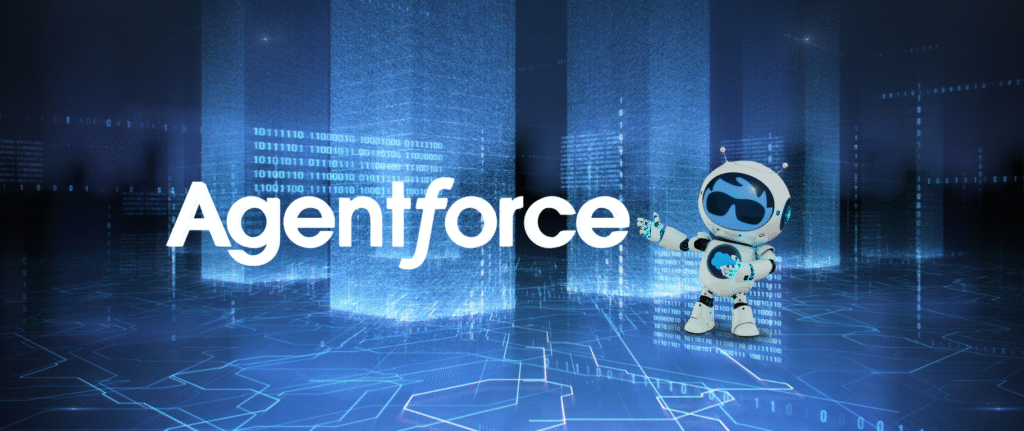
At Dreamforce 2024, Salesforce made its boldest move yet into the agentic AI era. More than 45,000 Trailblazers gathered to see how Agentforce — a groundbreaking suite of autonomous AI agents — will augment employees and handle tasks in service, sales, marketing, and commerce.
The message was clear: this marks a “new era” of enterprise AI, and the technology has matured enough for enterprise deployment.
Here’s what stood out for revenue leaders:
Agentforce in Slack Is Now Real Agentforce launched in beta in Slack in October 2024, with third-party agents available in the Slack Marketplace. This isn’t vaporware — it’s production-ready technology that enterprises can deploy today. Slack’s internal data shows customers have summarized more than 600 million messages, saving a collective 1.1 million hours. That’s concrete proof of productivity gains.
Salesforce Channels Bridge CRM and Conversation Salesforce Channels — a new channel type in Slack — seamlessly integrates CRM data and insights directly into the flow of work and conversations. Revenue teams can now access account history, opportunity updates, and customer context without leaving Slack. This is the conversational CRM foundation we’ve been describing.
1,000 Companies Built Agent Prototypes Live Salesforce set up an “Agentforce Launch Zone” where 1,000 selected customers built their own agent prototypes with guidance from Salesforce employees. These aren’t demos — they’re real implementations from companies solving real business problems. The use cases are proven.
The Productivity Numbers Are Undeniable 80% of desk workers using AI say it improves their productivity. When Slack demonstrates 1.1 million hours saved through simple message summarization, imagine what full workflow automation can deliver.
What This Means for Your Revenue Operations Strategy
If you attended Dreamforce or watched the keynotes, you saw the future. Conversational CRM isn’t a concept anymore — it’s a deployment strategy.
The companies that moved quickly after Dreamforce are already implementing Agentforce agents in Slack. They’re connecting Revenue Cloud, Sales Cloud, and Service Cloud into unified conversational workflows. They’re reducing admin work by 60-80% and seeing deal cycles compress by 25-40%.
The technology is ready. The platform is mature. The business case is proven. The only question is timing.
Early adopters are building competitive advantages right now. Fast followers are planning their strategies. Where will you be in six months when your competitors are closing deals 40% faster because their sales teams aren’t drowning in admin work?
Your Next Steps: Start Reducing Admin Work This Quarter
If you’re reading this and thinking “we need to explore conversational CRM,” here’s what to do:
1. Identify Your Highest-Pain Workflow (This Week)
Ask your sales team: “What admin task wastes the most time?” Map that process in detail. Count the systems involved. Calculate the hours spent. That’s your pilot candidate.
2. Audit Your Integration Readiness (Next Week)
List every system that workflow touches. Check API documentation. Understand authentication requirements. This tells you how complex the technical work will be.
3. Build the Business Case (Next Two Weeks)
Calculate what a 50-70% reduction in admin time would be worth. Factor in faster deal cycles, improved quota attainment, and better retention. Build the ROI model.
4. Find Your Executive Sponsor (This Month)
You need a senior leader who believes in this vision. Usually a CRO, VP of Sales, or Chief Revenue Officer. Without top-down support, the project won’t get the resources it needs.
5. Talk to A5 (This Month)
You don’t have to figure this out alone. We’ve built the roadmap. We know the pitfalls. We have the frameworks. A conversation costs nothing and might save you months of trial and error.
The Bottom Line on Conversational CRM and Sales Admin Work
Here’s what you need to know:
Sales admin work consumes 70% of your team’s time. That’s $930,000 per year for a 50-person team doing work that doesn’t close deals.
Conversational CRM eliminates 60-80% of that admin work by replacing form-filling with natural conversations. AI agents handle data entry, quote generation, research, forecasting, and coordination automatically.
The technology is proven. The CRM market reached $75 billion in 2023, but traditional CRM creates more work than it eliminates. The conversational AI market will exceed $31.9 billion by 2028 because it actually solves the problem.
Companies implementing conversational CRM see:
- 25-40% faster deal cycles
- 15-25% more deals closed
- 60-80% less time on admin work
- 8.7+ rep satisfaction scores (up from 6.2)
The question isn’t whether conversational CRM works. It’s whether you’ll adopt it now or wait for competitors to build an advantage you’ll spend years trying to match. Your sales team wants to sell. Give them the tools to do it.

